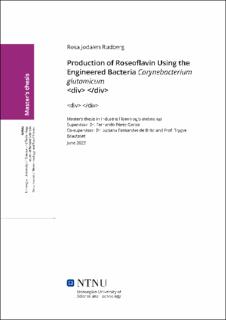| dc.description.abstract | Denne masteroppgaven hadde som mål å produsere det antimikrobielle stoffer roseoflavin ved bruk av riboflavin-overproduserende stammer av Coreynebacterium glutamicum som en mikrobiell platform. I dag produseres roseoflavin ved kjemisk syntese, som er kostbart, bruker farlige fobindelser og har et lavt molart utbytte på 5%. C. glutamicum brukes vanligvis i industrien og har blitt genmodifisert til å produsere flere verdifulle kjemikalier, inkludert riboflavin. I denne studien ble roseoflavin-biosyntesesporet fra Streptomyces davawensis testet i en riboflavin-produserende C. glutamicum-stamme. I den forbindelse ble genene rosA, rosB, rosC og ribM uttrykt ved hjelp av plasmider. I tillegg ble genet ribF, som koder for bifunksjonell riboflavin kinase / FMN adenylyltransferase i genomet til C. glutamicum, overuttrykt for å koble sammen roseoflavin og riboflavin sporene. Genene ribF-rosABC tilhørte roseoflavin biosyntese sporet, mens genet ribM kodet for en flavintransportprotein. De nykonstruerte plasmidene ble transformert inn i C. glutamicum- stammen som overproduserte riboflavin ved å overuttrykke riboflavin operonet ribGCAH (kalt riboCg). Dette resulterte i de tre følgende stammene: C. glutamicum(pSym-riboCg)(pVWEx1-rosABC) (kalt Roseo1), C. glutamicum(pSym-riboCg)(pVWEx1-rosABC-ribM) (kalt Roseo2), og (pSym-riboCg)(pVWEx1-ribF-rosAB-ribM) (kalt Roseo3). Vekstforsøk ved bruk av flaskedyrking ble utført for å evaluere celleveksten, og HPLC ble brukt til å kvantifisere produksjon av roseoflavin og riboflavin. Antimikrobielle tester ble utført for å evaluere giftigheten til roseoflavin for C. glutamicum, og for å undersøke egenskapene til transportproteinene kodet av ribM fra S. davawensis og ribX fra C. glutamicum. Fra vekstforsøkene ble det funnet at alle de konstruerte stammene, bortsett fra kontrollstammen, produserte roseoflavin. Sammenlignet med stammene konstruert i Fordypningsprosjektet til Rudberg (2022), som inneholdt genene rosAB og ribM, ble det funnet en reduksjon i roseoflavin-produksjon i stammene som overuttrykkte rosC. Derimot økte roseoflavin-produksjonen når ribF ble overuttrykt i Roseo3-stammen. Roseo3 oppnådde den høyeste roseoflavin konsentrasjonen på 4,065 ± 0,901 g/L. Verdien påvirkes imidlertid av konsentrasjonen til en ukjent forbindelse med liknende retensjonstid som roseoflavin. Det er verdt å merke seg at overuttrkkelse av ribM viser seg å være gunstig siden det reduserte roseoflavin-giftigheten samtidig som roseoflavin produksjonen økte. Fra de antimikrobielle testene ble det oppdaget at ribM fungerte som en antiporter som transporterte roseoflavin ut av cellene samtidig som den importerte riboflavin. ribX ble funnet til å kode for en riboflavin- og roseoflavin-importør på grunn av de liknenede strukturene til de to forbindelsene. Videre avslørte de antimikrobielle testene en roseoflavin-inhiberingskonstant på 0,05 g/L, som representerer terskelkonsentrasjonen av roseoflavin som begrenser veksten av C. glutamicum celler. Totalt sett legger dette arbeidet et solid grunnlag for bærekraftig og effektiv mikrobiell produksjon av roseoflavin, og tilbyr et lovende alternativ til kostbare og farlige kjemiske syntesemetoder. Imidlertid kreves det videre forskning for å optimalisere produksjonsmetoden, oppdage den ukjente forbindelsen som påvirker roseoflavin-titerne, og utforske potensielle anvendelser for produksjon i større skala i bioreaktorer. | |
| dc.description.abstract | This Master's thesis aimed to produce the antimicrobial compound roseoflavin using strains of Corynebacterium glutamicum that overproduces its precursor riboflavin as a microbial platform. Roseoflavin is currently produced by chemical synthesis, which is costly, employs hazardous compounds, and has a low molar yield of 5%. C. glutamicum is commonly used in industry and has been engineered to produce several value-added chemicals, including riboflavin. In this study, the roseoflavin biosynthetic pathway from Streptomyces davawensis was explored in a C. glutamicum producing riboflavin strain. In this regard, the genes rosA, rosB, rosC, and ribM were plasmid-based expressed. Additionally, the bifunctional riboflavin kinase / FMN adenylyltransferase gene ribF from C. glutamicum was overexpressed connecting the roseoflavin and riboflavin pathways. The genes ribF-rosABC belonged to the roseoflavin biosynthesis pathway, while the gene ribM coded for a flavin transporter protein. The newly constructed plasmids were transformed into a riboflavin-producing C. glutamicum strain, overexpressing the riboflavin operon ribGCAH (named riboCg), resulting in the following three strains: C. glutamicum(pSym-riboCg)(pVWEx1-rosABC) (named Roseo1), C. glutamicum(pSym-riboCg)(pVWEx1-rosABC-ribM) (named Roseo2), and C. glutamicum(pSym-riboCg)(pVWEx1-ribF-rosAB-ribM) (named Roseo3). Growth experiments in shaking flasks were performed to evaluate the cell growth, and HPLC was utilized to quantify the riboflavin and roseoflavin production. Antimicrobial tests were performed to evaluate the toxicity of roseoflavin in C. glutamicum, and to investigate the impact of the transporter proteins encoded by ribM from S. davawensis, and ribX from C. glutamicum. In the growth experiments, it was found that all the constructed strains, except for the control strain, produced roseoflavin. In comparison to the strains constructed in the Specialisation project of Rudberg (2022), containing the genes rosAB, and ribM, it was found a decrease of roseoflavin production in the strains overexpressing rosC. Contrarily, overproducing ribF in the strain Roseo3 increased roseoflavin production. Roseo3 achieved the highest roseoflavin titer of 4.065 ± 0.901 g/L. It is noteworthy that the roseoflavin final titers might have been influenced by an unknown analyte detected at a similar retention time as roseoflavin. Notably, the expression of the ribM gene proved to be beneficial since it decreased roseoflavin toxicity while increasing roseoflavin productivity. The antimicrobial tests indicated that ribM is an antiporter, co-transporting roseoflavin out of the cells while importing riboflavin. ribX was revealed to encode a riboflavin and a roseoflavin importer, due to the similar structures of the two compounds. Furthermore, the antimicrobial tests revealed a roseoflavin inhibitory constant of 0.05 g/L, which represents the threshold concentration of roseoflavin that limits the growth of C. glutamicum cells. This work lays a solid foundation for the sustainable and efficient microbial production of roseoflavin, offering a promising alternative to costly and hazardous chemical synthesis methods. However, further research is necessary to optimize the production method, separate the unknown compound influencing the roseoflavin titers, and explore potential applications for scaling-up production in bioreactors. | |
